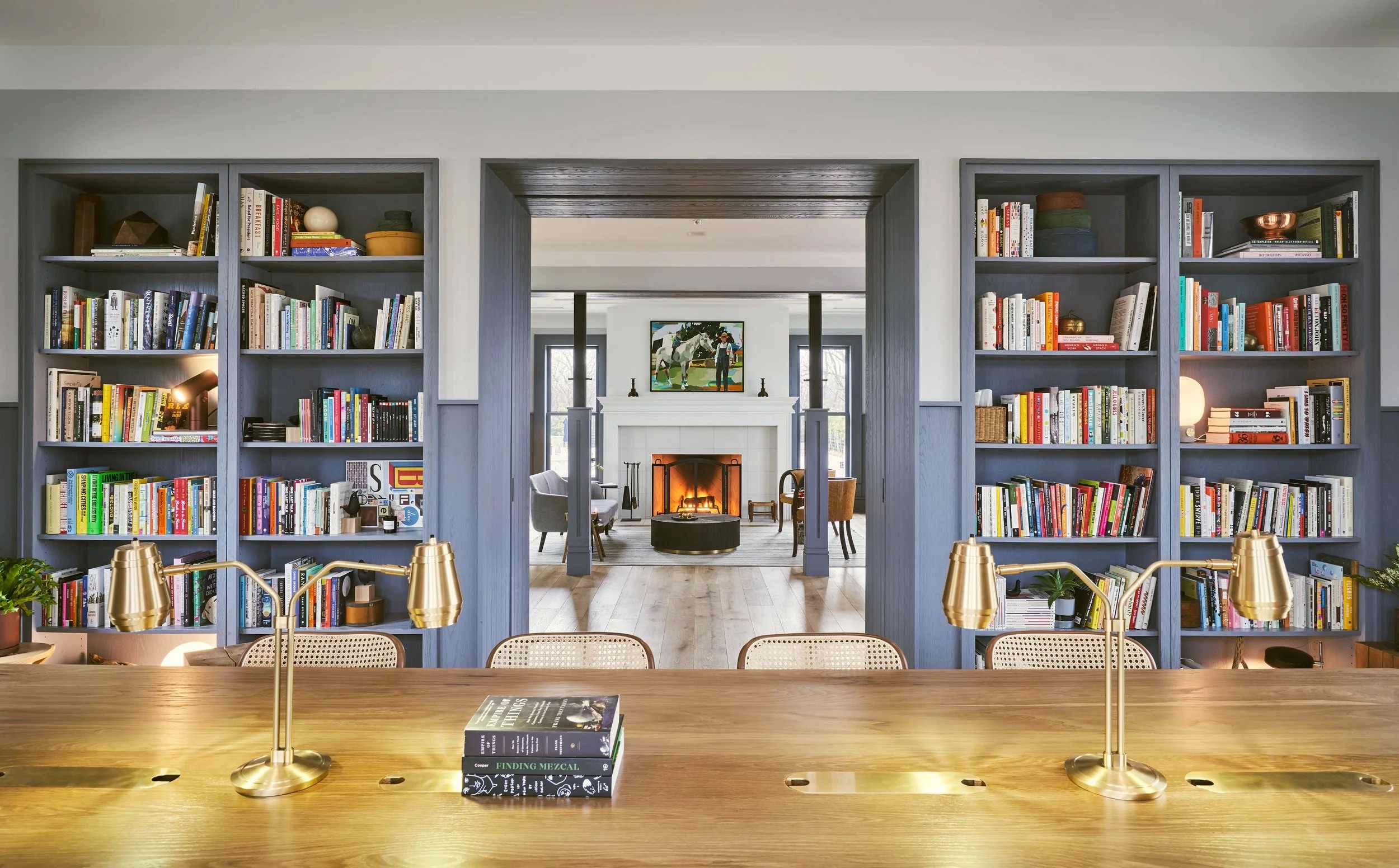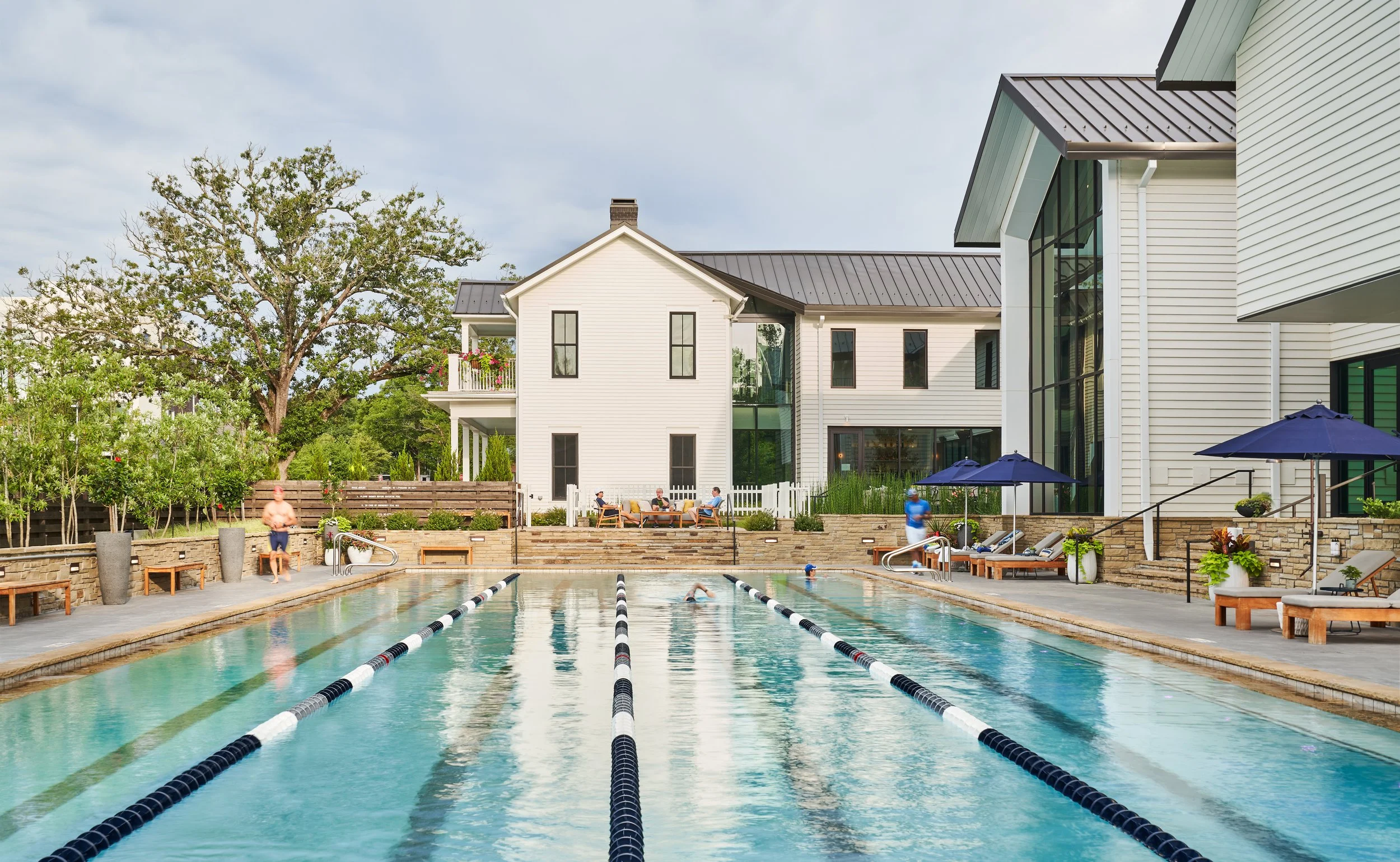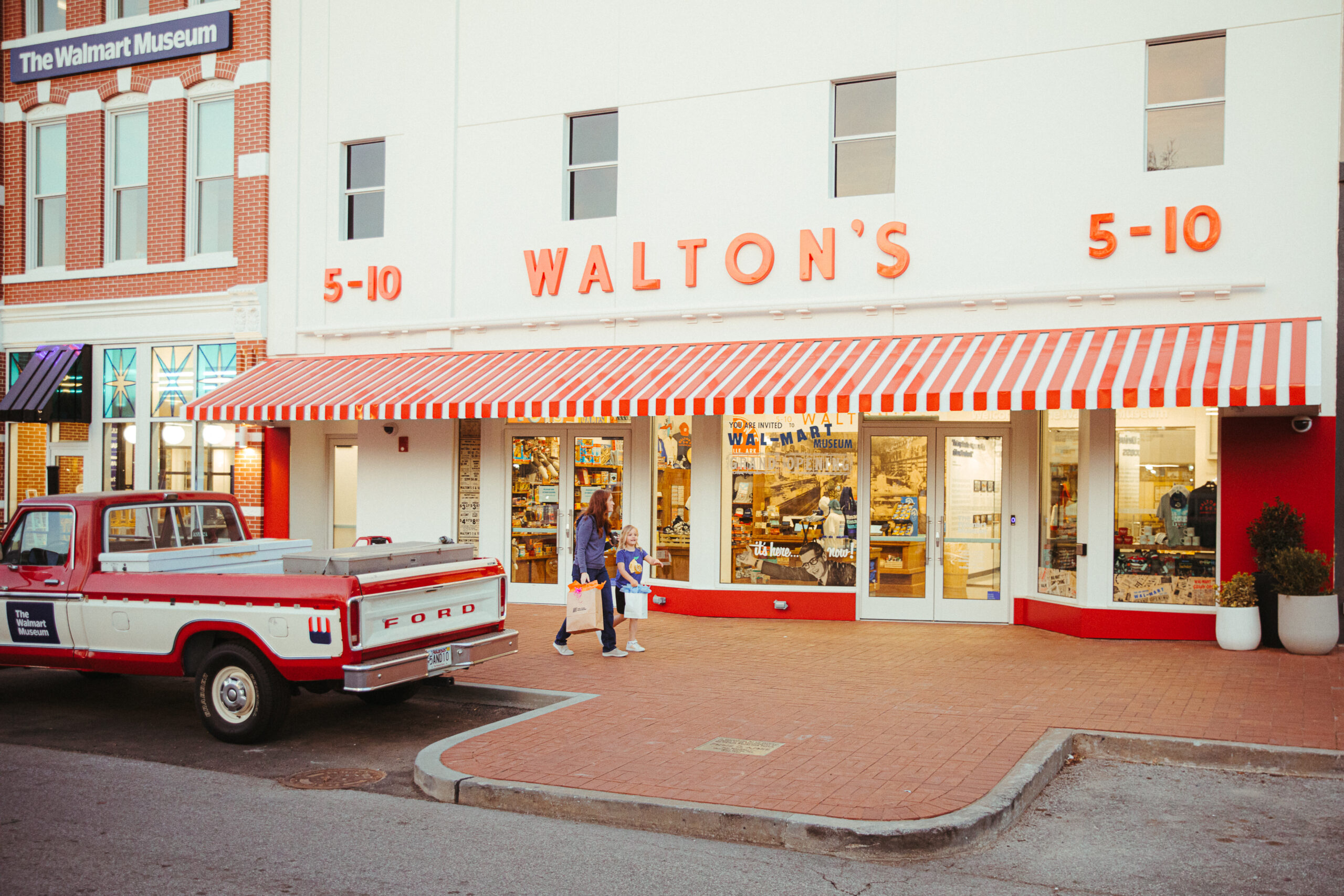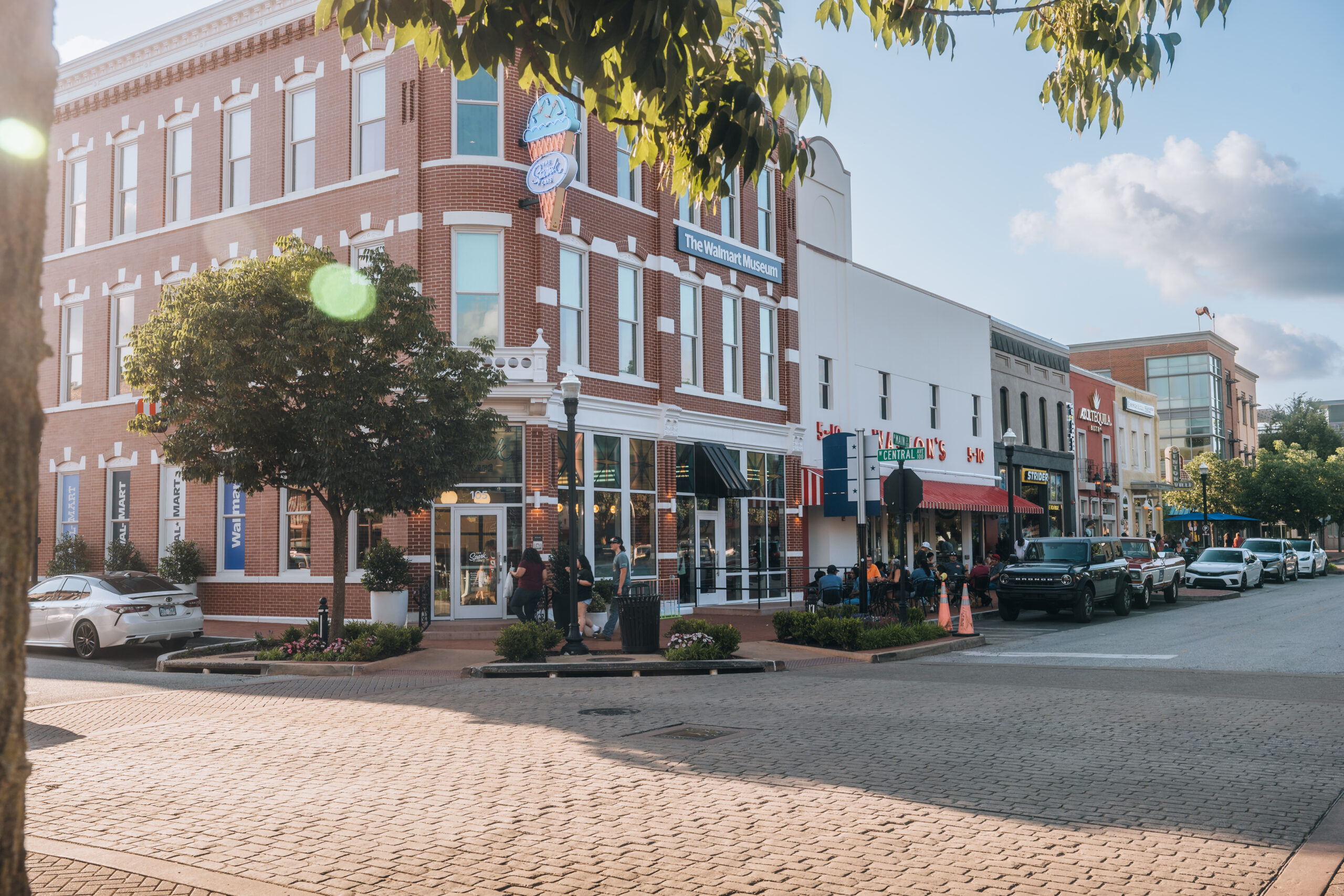
Hip, Healthy, and Well Into a Major Revitalization, Bentonville, Arkansas, Breaks Out of Its Walmart Shell
Words by Rebecca Deurlein and Nicole Letts
Photos courtesy of Visit Bentonville
We expected the home of Walmart to be caught in the Sam Walton era. Instead, it is progressive, outdoorsy, artsy, and youthful. The town hums with energy. Businesspeople flock to coffee shops in the morning, hustle to meetings mid-day, and dip into sophisticated bars by night. Architecture varies from modern structures—one with bike paths on its exterior—to charming bungalows with craftsman details. As we heard on our Big on Bentonville golf cart tour, “Everybody and anything is welcome here.”
Rebecca pursued wellness activities, but because rain was in the forecast, her plan to hit the trails, fly a plane, and play sports was squelched. In travel, sometimes you need to punt, and that’s exactly what she did, filling her itinerary with indoor wellness. Meanwhile, Nicole took in as much art and history as possible, finding breathtaking pieces and curious artifacts in unsuspecting places.
Rebecca’s Itinerary
Waking up with Yoga
One rainy morning, I walked a couple of blocks to Yoga Story, a studio celebrating its 15th anniversary and offering asanas and workouts of every type and temperature, including power, flow, hot, prenatal, and restorative. I took advantage of the studio’s incredibly reasonable $10 drop-in rate and enjoyed the accepting, welcoming atmosphere that greeted me.
Sometimes joining a class as a traveler can make you feel like an outsider, but that wasn’t the case here. I was given a mat, a block, a strap, and towels—everything I needed to feel like I belonged. Instruction flowed clearly, and there wasn’t an ounce of judgment as participants practiced at their own pace.

It was an hour of focus and freedom and of the me-time that was sorely lacking in my day-to-day life. The next day, I was sore in all the best ways. I recommend starting some of your vacation days with a session as a gentle reminder of the importance of self-care.
Escaping Technology
One of the benefits of staying at the new Motto by Hilton, comes from its partnership with Blake Street House, also known as BlakeSt. Later in the day, I made use of this perk and found a hybrid social and wellness gathering space unlike anything else I’ve seen.
The beautifully restored farmhouse is filled with whimsical art, an impressive fitness center, a studio class schedule with more than 100 (!) options, and an upscale locker room with a glorious rain shower where you can soap up with house-made products. What I loved most, though, was the club’s adherence to technology rules as in no talking on the phone without stepping outside and using technology at all in designated areas.
If you’re a Hilton Diamond Member, you can purchase a day pass and have the run of the entire house. Chat and imbibe in the club lounge with a full bar, groove to your favorite tunes in the sound lounge, share brunch with a friend at BlakeSt’s signature restaurant, Rockhound, and lounge on the front porch or around the always-82-degree, Great Gatsby-esque pool complex with a hot tub and cold plunge.
We expected the home of Walmart to be caught in the Sam Walton era. Instead, it is progressive, outdoorsy, artsy, and youthful.
Eating Mindfully
Let’s go ahead and admit that no one expects to visit a Southern city and find a lot of healthy food, but Bentonville is progressive and respectful of food allergies and restrictions.
Nicole and I were impressed with the dining scene here. It is culturally diverse, and there’s something for every budget. It even features some James Beard Foundation Award nominees, like Conifer. This eatery has a 100% gluten-free menu, along with dairy-free, nut-free, vegan, and vegetarian designations, allowing you to order with confidence.
You’ll find gluten-free options across the city, including craft beers from Stoic Brews Alternative, filled-to-the-brim savory and sweet delicacies from Crepes Paulette, and tacos, burgers, and pizzas from Meld Kitchen & Sandwich Bar. Bar Cleeta, where Nicole and I enjoyed our favorite meal of the trip, serves antibiotic- and hormone-free meats and locally sourced ingredients that are out of this world.
Nicole’s Itinerary
Wandering with Wonder
While Bentonville’s mountain biking culture is the main draw for outdoor adventurers, Crystal Bridges is another well-known attraction. Founded by philanthropist Alice Walton, whose father Sam Walton founded Walmart, Crystal Bridges Museum of American Art opened in 2011 with a 134-acre campus designed by renowned architect Moshe Safdie. I could have spent several days at the museum alone, but I managed to squeeze as much as I could.


I began my tour on the Orchard Trail, enamored by the Yayoi Kusama Flowers exhibit. The larger-than-life sculptures in vibrant colors and exaggerated shapes feel almost like walking amid the gardens of Wonderland. If you can’t make it inside the main building, it’s a worthwhile alternative. Plan to also walk to Frank Lloyd Wright’s Bachman-Wilson House, an example of his Usonian design.
In the permanent exhibition galleries, visitors will find art by prominent artists such as Amy Sherald and Kehinde Wiley, the portrait painters for Michelle and Barack Obama, respectively, as well as works by hundreds of other artists. In total, the museum has more than 3,500 pieces in its rotating collection.
Compton Gardens & Arboretum is walkable from the main Crystal Bridges campus and is connected by a paved trail system. A living tribute to Arkansas’ natural beauty, Compton Gardens & Arboretum was originally cultivated by Neil Compton and has since been preserved to showcase native plants. The outdoor spaces are organized into five distinct gardens that aim to inspire appreciation and promote the conservation of the state’s natural spaces, and there is a series of public art sculptures to see, too.
Digging into History
One of the most interesting places I visited was the Peel Museum & Botanical Garden. In fact, as I drove into the parking lot of a Walmart, I was pretty sure I was in the wrong place, but I was exactly where I was supposed to be. The Peel Museum & Botanical Garden is an 1800s Italianate family home surrounded by seasonal gardens inspired by the Victorian era. On a mission to preserve the rich history of late 19th-century northwest Arkansas, tours include stories of the contents and ephemera of the home. I was especially smitten with the parlor, which includes elements of courting culture like a spiral courting candle used to set a time limit for a suitor’s visit.
Back in town, you’ll find the meticulously reconstructed Terry Block building, which is now the Walmart Museum. It transports visitors back to 1950, beginning in Sam Walton’s original store, Walton’s 5&10. The museum’s first floor showcases Walmart’s early history, featuring artifacts like the original layout for the second store and Sam Walton’s famous Ford F-150. Upstairs, the experience becomes interactive, chronicling the company’s story from the 2000s onward with engaging digital displays and a hologram theater, where a virtual Sam Walton shares his story.
Everybody and anything is welcome here.
Bars of Bentonville
Lady Slipper
In the cellar of Bentonville’s historic Massey building, Lady Slipper is a sophisticated yet welcoming speakeasy with a unique collection of art and decor. The menu offers shareable plates with Spanish, French, and Latin American influences, and the inventive cocktail list includes the namesake Lady Slipper, made with gin, Cocchi Americano, blueberry lemon syrup, and prosecco.
Tower Bar
Offering some of the best views in Bentonville, Tower Bar is an elegant retreat on the sixth floor of the Momentary, a decommissioned cheese factory that now serves as a creative hub for art, food, and music. By day, it’s a casual spot for coffee and light bites, and by night, it becomes a destination for ages 21 and older to find craft cocktails and other spirits. Plan to visit just in time to catch the sunset.
Preacher’s Son
Located in a thoughtfully restored historic church, Preacher’s Son offers an elegant dining experience just steps from the Bentonville City Square. The building, which served as the First Christian Church for nearly a century, features soaring chapel ceilings and magnificent stained art glass, creating a one-of-a-kind atmosphere.


